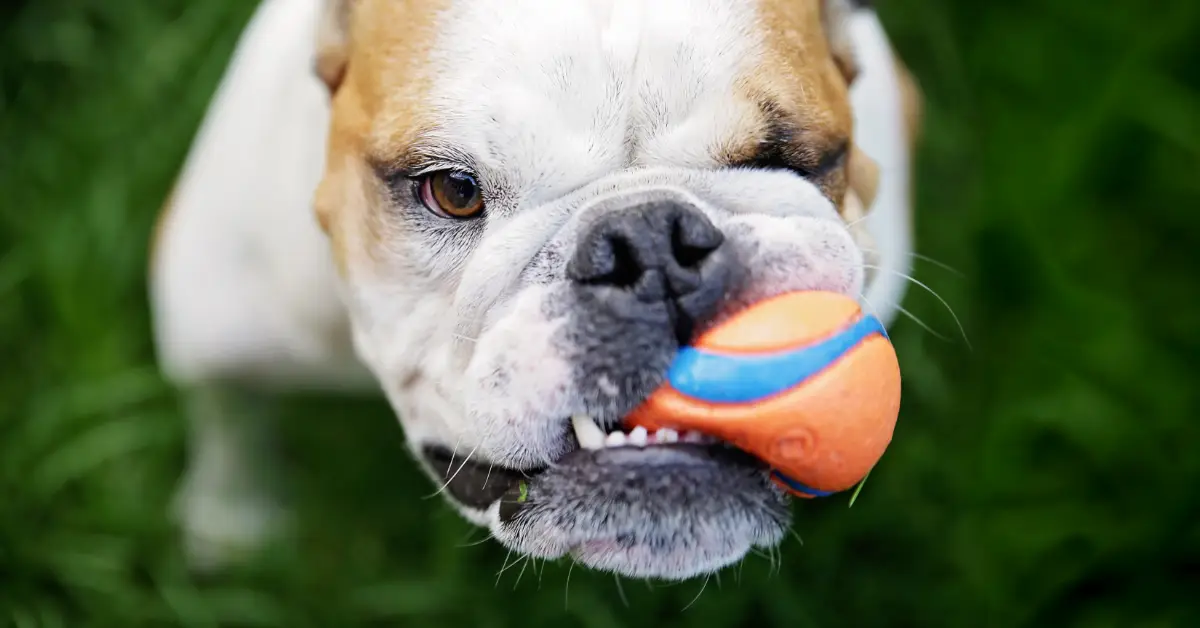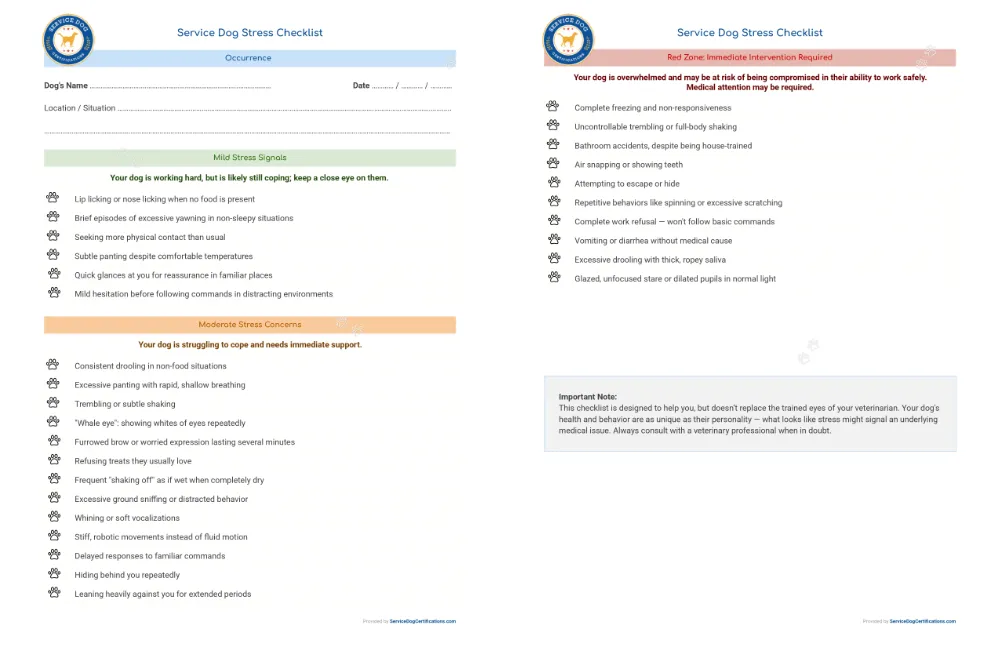Complete Checklist of Stress Signs for Service Dogs

Service dogs can’t tell you when they’re overwhelmed, but they show it through body language and behavior changes. Learning to spot these signals early prevents bigger problems down the road.
Stressed service dogs become unreliable. They miss medical alerts, ignore commands they usually follow perfectly, and may develop behavioral issues that could end their working career. Since dogs mirror their handler’s stress levels and stress hormones stay elevated for up to 72 hours, small stressors can quickly snowball into serious problems.
Recognizing stress isn’t just about your dog’s comfort, though that matters. It’s about maintaining the partnership that keeps you both safe and independent, and making sure your dog is able to perform their service dog tasks at all times.
Below is a handy checklist to help you recognize the first signs of stress in your service dog.
In this article:
- Service dog stress checklist
- Stress triggers in service dogs
- Responding to stress in service dogs
- Preventing stress before it starts
Service Dog Stress Checklist
Download a printable version of this checklist of stress signs in service dogs here.
Stress Triggers in Service Dogs
Understanding what typically stresses service dogs helps you spot problems before they get out of hand.
Environmental Overload
Too much happening at once is a big one. Your dog might handle crowds fine, but add loud noises, strong smells, and people trying to pet them all at once, and it becomes overwhelming quickly. Think about a dog navigating a busy farmer’s market when someone drops a crate of apples near the live music while cheese and bread smells mix with the crowd of people reaching toward them.
Working While Unwell
Being asked to work when they don’t feel well creates frustration. A dog with an ear infection trying to do mobility work will struggle with balance. A diabetic alert dog with a stuffy nose can’t smell blood sugar changes as clearly. They know something’s wrong with their performance but can’t figure out what, which makes the stress worse.
Social Suppression
Constant social pressure wears them down. Picture your dog walking through a shopping mall — every store employee who coos at them, every child who runs up asking to pet them, every other dog they pass without being allowed to sniff or greet. By the end of the trip, they’re mentally exhausted from saying “no” to every natural dog instinct.
Handler Stress Transfer
Your own stress affects them more than you might realize. Research shows that dogs actually synchronize with their handler’s stress hormones. If you’re anxious about a medical appointment, your dog picks up on that tension and starts scanning for threats even before you get to the doctor’s office. They’re carrying your worry on top of their job of keeping you safe.
Responding to Stress in Service Dogs
How you handle these moments shapes whether your dog bounces back stronger or starts expecting the worst from challenging situations.
Mild Stress Response
When you spot early warning signs, stay calm and acknowledge their hard work without making a big deal about it. Consider bringing out a special toy that only appears during tough outings — it gives them something positive to focus on, rather than just enduring the experience. If your dog is lip-licking during a routine grocery trip, offer quiet praise when they refocus on you rather than fussing over their stress.
Moderate Stress Intervention
This level means you need to step in and help them cope. Move away from whatever’s bothering them if you can, find a quieter spot, and give them a simple command they can nail. When your dog is panting heavily in a crowded restaurant, guide them to a less busy corner and ask for a “sit” they can succeed at. You’re reminding them they can handle tough situations.
Red Zone Crisis Management
Stop everything immediately. Don’t try to push through your plans or stick to your schedule. Find the nearest quiet space and let them decompress without any work demands. If your dog completely shuts down during a medical appointment, take them outside to the parking lot and wait while they regain their composure. Sometimes the best help is permitting them to not be “on” for a few minutes.
Quick Reset Technique
When stress is building but hasn’t reached crisis mode, try issuing rapid-fire, easy-to-follow commands. “Sit. Good! Touch my hand. Great! Down. Perfect!” This helps switch their brain from panic mode back to problem-solving mode. It works especially well when you see those moderate warning signs starting to pile up.
What Not to Do
Don’t comfort them with “It’s okay, sweetie” when they’re stressed — you’re accidentally confirming there is something to worry about. Don’t force them to work through overwhelming situations. And never punish stress signals. You want them to keep telling you how they feel, not hide their struggles.
Preventing Stress Before It Starts
Building your dog’s ability to handle tough situations is easier than constantly managing stress after it happens.
Create Predictable Routines
Small patterns help your dog feel prepared instead of anxious about unknown challenges. When they see you grab your keys and their working vest, they should feel calm confidence rather than worry. Even something as simple as always putting their service dog vest on in the same order can become a comforting ritual that signals “we’ve got this.”
Schedule Real Downtime
Your dog needs genuine time off from being a service dog. Not just rest — actual permission to be a regular dog. Let them sniff whatever they want on walks, chew their favorite toys, or roll around in grass. Natural dog behaviors actively lower stress hormones. Think of it as their version of meditation or yoga.
Maintain Physical Health
Dogs dealing with pain, ear infections, or stomach problems have no energy left for handling emotional stress. A dog with sore joints from arthritis will get stressed much faster in crowded places because everything already feels harder. Regular vet care, good food, enough sleep, and daily exercise create the foundation that everything else builds upon.
Manage Your Own Stress
Your emotional state directly affects your dog’s well-being. When you’re anxious about a doctor’s appointment, your dog feels that tension and starts looking for threats before you even leave the house. Learning to manage your own stress — whether through deep breathing, medication, or therapy — actually becomes part of your dog’s healthcare routine.
Follow the 80/20 Rule
Try to keep about 80% of your dog’s experiences manageable and only 20% genuinely challenging. Rate your outings, grocery stores might be a 3 out of 10, doctor visits a 7, and crowded festivals a 9. If you notice several difficult days in a row, plan some easier activities to help them recover. Even service dogs need mental health days.
Build Confidence Through Practice
Dogs who trust their abilities bounce back faster from challenging situations. Spend time each week practicing familiar commands somewhere they feel comfortable, your backyard, a quiet park, or even inside your house. When they have a solid foundation of “I know I can do this,” it carries over into more challenging public spaces.
Your service dog has one of the hardest jobs in the animal world. They’re always working, always monitoring your needs, always suppressing their natural instincts to focus on your safety. Understanding their stress signals and responding appropriately builds a partnership based on real communication and trust.
Every stress signal your dog shows you is their way of saying, “I’m struggling and I trust you to help me.” Take care of that trust, and you’ll discover a much deeper partnership than you might have thought possible.
About the Author: The writing team at Service Dog Certifications is made up of folks who really know their stuff when it comes to disability laws and assistance animals. Many of our writers and editors have service dogs themselves and share insights from their own experiences. All of us have a passion for disability rights and animals.
Latest Posts

Dangerous Materials Hiding in Your Dog Products
Jake’s German Shepherd began developing strange rashes around his collar. Three vet visits later, they figured out the leather was treated with chromium — a chemical that irritates sensitive skin. Jake had no idea his dog’s collar contained industrial chemicals. Most dog owners don’t know what goes into the products they buy. Many companies use […]

Read More

Can You Bring a Service Dog to a Basketball Game?
Yes, you absolutely can bring your service dog to basketball games. Whether you’re heading to your local high school tournament, a packed college rivalry game, or splurging on NBA tickets, the Americans with Disabilities Act protects your right to be accompanied by your service dog anywhere the public can go. When you arrive, venue employees […]

Read More

Best Pet Health Insurance Providers
If you own a pet, you know how important — and expensive — vet care can be. One way to offset those costs is to purchase pet health insurance. Like typical health insurance, pet insurance is available at many price points, and can cover all, most, or only some of your vet-related costs. It can […]

Read More
